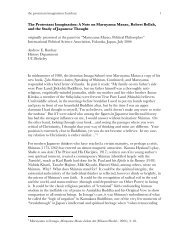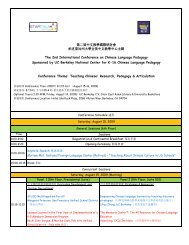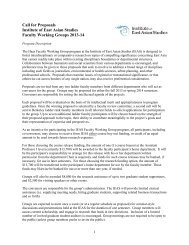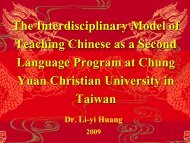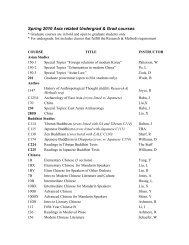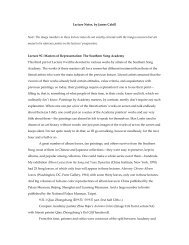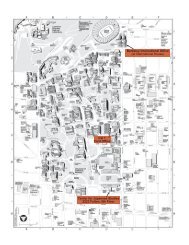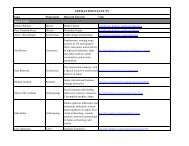Third Edition Spring 2013 - Institute of East Asian Studies, UC ...
Third Edition Spring 2013 - Institute of East Asian Studies, UC ...
Third Edition Spring 2013 - Institute of East Asian Studies, UC ...
You also want an ePaper? Increase the reach of your titles
YUMPU automatically turns print PDFs into web optimized ePapers that Google loves.
appears that Japanese monks are not so singular in their ability toget married and at the same time be regarded as having religiouspower by their parishioners.The illusion that Japan’s married clerics are somehow singularin Asia is a popular myth that continues to the present. Examplesin both the popular press 24 and in scholarly writing 25 pointto a persistent belief that Japan’s phenomenon <strong>of</strong> monks who aremarried is a very “Japanese” tradition, consistent with a unique,long past. The historical genealogy <strong>of</strong> this belief can be seen in thelate Meiji period, when apologists from both the lay context andpriestly context began to build their case that married monks werefully in line with the “Japanese” spirit. While this spirit <strong>of</strong> nationalismcan be understood in its historicized context <strong>of</strong> the project<strong>of</strong> building a kokutai ( 国 体 , national body or national identity), itseems suspect to repeat these notions in the current age when anample body <strong>of</strong> evidence rshows that married monks in Nepal areconsidered full and proper members <strong>of</strong> the sangha by their society.What is unique in the Japanese context, beyond the non-trivialfact that the monks in Japanese Buddhism continue to take vows <strong>of</strong>celibacy during their ordinations, is the fact that this widespread“problem” <strong>of</strong> nikujisaitai combined with the pressures <strong>of</strong> modernizationduring the Meiji period resulted in rapid change in the relationshipbetween the sangha, government, and society.This doctrinal contradiction related to marriage is not asmall matter, as pushes to eliminate nikujikisaitai from JapaneseBuddhism continue to the present day. It also may be confusing toconsider that Newar monks do <strong>of</strong>ficially give up their vows <strong>of</strong> celibacywhile Japanese monks never disrobe and “<strong>of</strong>ficially” returnto lay life. However, I urge the reader to focus on the similarities <strong>of</strong>how the monks are perceived in both cultures. In both the Newartradition and in the Japanese tradition these figures are consideredmonks. It appears, then, that the married Japanese Buddhist monk(despite the breaking <strong>of</strong> his vows <strong>of</strong> chastity) is every bit as religiouslypowerful and Buddhist as his Newar counterpart (despitethe Newar having given up his robes <strong>of</strong>ficially). Rather than a re-duction in status that should come with “giving up” renunciatedlife, modern Japanese Buddhists appear to have the same status asreligious figures for their parishioners, just as Newar householdermonks and priests continue to do.Japanese Buddhism is still in a state <strong>of</strong> transition, as the doctrinalfights over nikujikisaitai have still not been entirely resolved.However, it seems unlikely, with a majority <strong>of</strong> the clergy havingfamilies, that there is any way to recork the bottle. It is up to thereader to decide if Japanese Buddhism’s transition to a Newar-esquemodel has left it in a stronger position to answer the religiousconcerns <strong>of</strong> 21st century laity or if it has done irreparable damageto the integrity <strong>of</strong> Buddhism.24 Sueki 2012; Inoue 201225 Nakamura 2011101 Robert Bowers Curl Laicization in Japanese Buddhism 102




